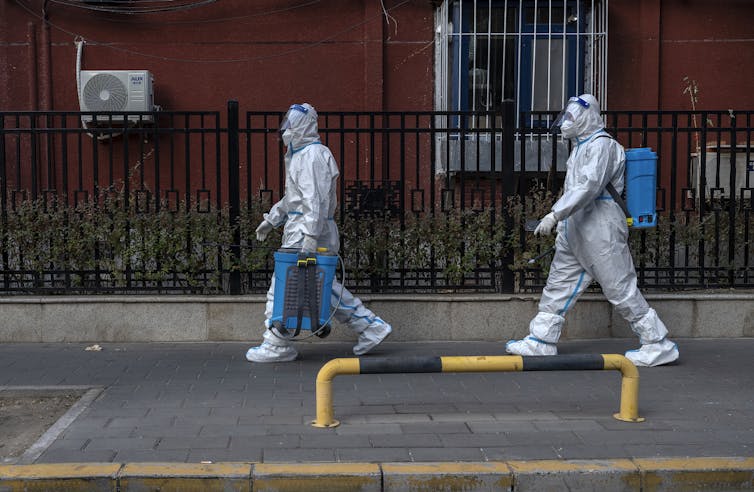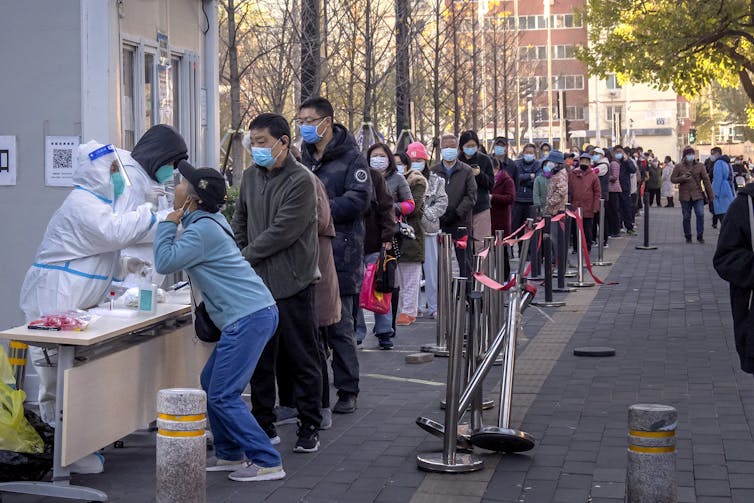After nearly three years of aiming to eliminate COVID-19 through mass lockdowns, robust contact tracing programs, and international travel bans, the Chinese government has announced it is rolling back the “zero-COVID” policies that helped suppress the spread of coronavirus in the country.
The Chinese Communist Party announced these changes on 7 December, as rates of COVID-19 are on the rise in major cities, following protests demanding the end of zero-COVID policies.
The situation in China stands in stark contrast to the trajectory of the pandemic in the United States. SARS-CoV-2 emerged with a bang, but thanks to a strong vaccination effort and the fact that a large portion of US residents have been infected with the coronavirus, COVID-19 cases seem to be reaching somewhat of a steady state and normal life has mostly resumed.
I am a medical anthropologist who studies public health trends in China from an epidemiologic and social perspective.
After largely containing the coronavirus in 2020, China began enforcing a strict zero-COVID policy leading up to the Beijing Olympics in 2022. The result is that China has not followed the standard path of a pandemic where people slowly gain immunity through exposure or vaccination, allowing the society to open up over time.
Combined with questions about the efficacy of China’s vaccines and comparatively low vaccination rates, many public health experts think that China will be hit hard by the coronavirus as the country rapidly lifts its zero-COVID policy.
China’s Initial Reaction to COVID-19
Public health campaigns and control of the emerging diseases in China are entirely reliant on and directed by the government, which promotes health both for the good of the people and the nation.
When COVID-19 emerged, the Chinese government was quick to institute mask-wearing policies and testing regimens, and it locked down the city of Wuhan and the surrounding region where the coronavirus originated.
With only the aid of these non-pharmaceutical interventions, the Chinese government was very successful in containing the spread of COVID-19 after the initial wave hit Wuhan.
From the time that China started recording cases in late December 2019, until the government ended its initial period of lockdown in April 2020, the government documented 82,000 cases of COVID-19 and just over 3,300 deaths.
Though not officially called a zero-COVID policy at the time, the control measures were born out of the goal of eliminating COVID-19 from the country.
Ramping Up Zero-COVID
Life returned to normal in China after the initial wave of COVID-19 ravaged Wuhan. For most of 2020 and the first half of 2021, Chinese people were out and about in shopping malls, restaurants, and bars.
During this same period, the coronavirus was rampaging across the US, Europe, and other regions of the world, leading many health experts to say that the lockdowns in China, though brutal, were successful. Between May 2020 and August 2021, people in China saw COVID-19 as a distant threat and supported the government’s actions.
The situation changed in August 2021 when the Chinese government officially adopted what it calls the “Dynamic zero-COVID” strategy to combat the new delta variant. This strict prevention policy included provisions for mass lockdowns aimed at eliminating the disease in a particular region, even if just a small number of cases were found.
China ramped up enforcement of the policy as the 2022 Winter Olympics approached. A single case could trigger a massive lockdown where the government would severely limit people’s movement and enforce quarantines, as occurred several times in Shanghai Disney.
In some instances, people were held in stores or office buildings for several days after exposure to an infected person.
Summer and fall 2022 were relatively quiet, with only around 1,000 confirmed infections per day.
But since early November 2022, COVID-19 cases in China have climbed steadily, with more than 35,000 new cases detected per day in the first week of December.
What Happens Next?
As of early December, COVID-19 rates in China were still relatively low compared to many places, including the US. But China faces some unique challenges thanks to low levels of immunity in the population and a disease control strategy that prioritized nonpharmaceutical interventions like mask-wearing, social distancing and frequent testing over vaccine administration.
To date, 90 percent of the population in China has been vaccinated. Older people have been more reluctant though, and only 66 percent of those over 80 have received two doses of a vaccine.
A further concern arises from studies indicating that China’s vaccines may not be as effective as the mRNA vaccines used in the West. So far, China has not been willing to import and administer Western mRNA vaccines.
In addition to concerns over vaccination, the zero-COVID policy has, to a large extent, successfully suppressed the coronavirus in China. The result is that since most people have not been exposed to the virus, they have not had a chance to develop immunity. This has likely left the country very susceptible to a large outbreak.
There is also a social dimension to the problems facing China today. Recurring lockdowns over the past year have damaged the economy and lessened peoples’ patience with restrictive policies.
Despite government efforts to limit access to outside information, people in China are learning that most other countries are functioning normally. Maintaining stringent zero-COVID policies has become increasingly difficult, as they wear on a populace that wants life to return to normal.
The 7 December announcement to ease COVID-19 restrictions is a continuation of a trend a few weeks in the making, but has been seen by many as a response to the widespread protests.
Testing centers are closing and infected people are now allowed to quarantine at home for the first time since the pandemic began. The digital health passes, issued to people who tested negative through daily PCR tests, are also no longer required to enter public places.
In much of the world, COVID-19 has followed that natural trajectory of a pandemic. The story is different in China.
The relaxation of zero-COVID policies may bring China more in line with the rest of the world in terms of what the people there can do, but the virus also gets a chance to run its natural course now that government actions will not suppress the spread.
It is likely that in the coming months, the Chinese people will face the pain and suffering that many other places experienced in 2020 and 2021.
(This article was originally published at The Conversation. Read the original article here.)





